Financial Management Report: Techniques and Ethics at Tesco Plc
VerifiedAdded on 2023/01/06
|17
|4617
|36
Report
AI Summary
This report provides a comprehensive analysis of financial management principles, focusing on decision-making techniques, stakeholder management, and ethical considerations within the context of Tesco Plc. It explores various approaches to decision-making, including knowledge-based and formal/informal approaches, and examines techniques such as make or buy decisions and T-charts. The report also delves into the factors affecting decision-making, like environment and financial considerations, along with the management of stakeholder conflicts and agency theory. Furthermore, it highlights the importance of management accounting, fraud detection and prevention, and ethical decision-making processes. The study includes a company overview of Tesco Plc, its history, and its financial performance, providing a real-world application of the concepts discussed. The report concludes with a reflective analysis of the learning process and challenges encountered during the study.

Financial Management
Paraphrase This Document
Need a fresh take? Get an instant paraphrase of this document with our AI Paraphraser
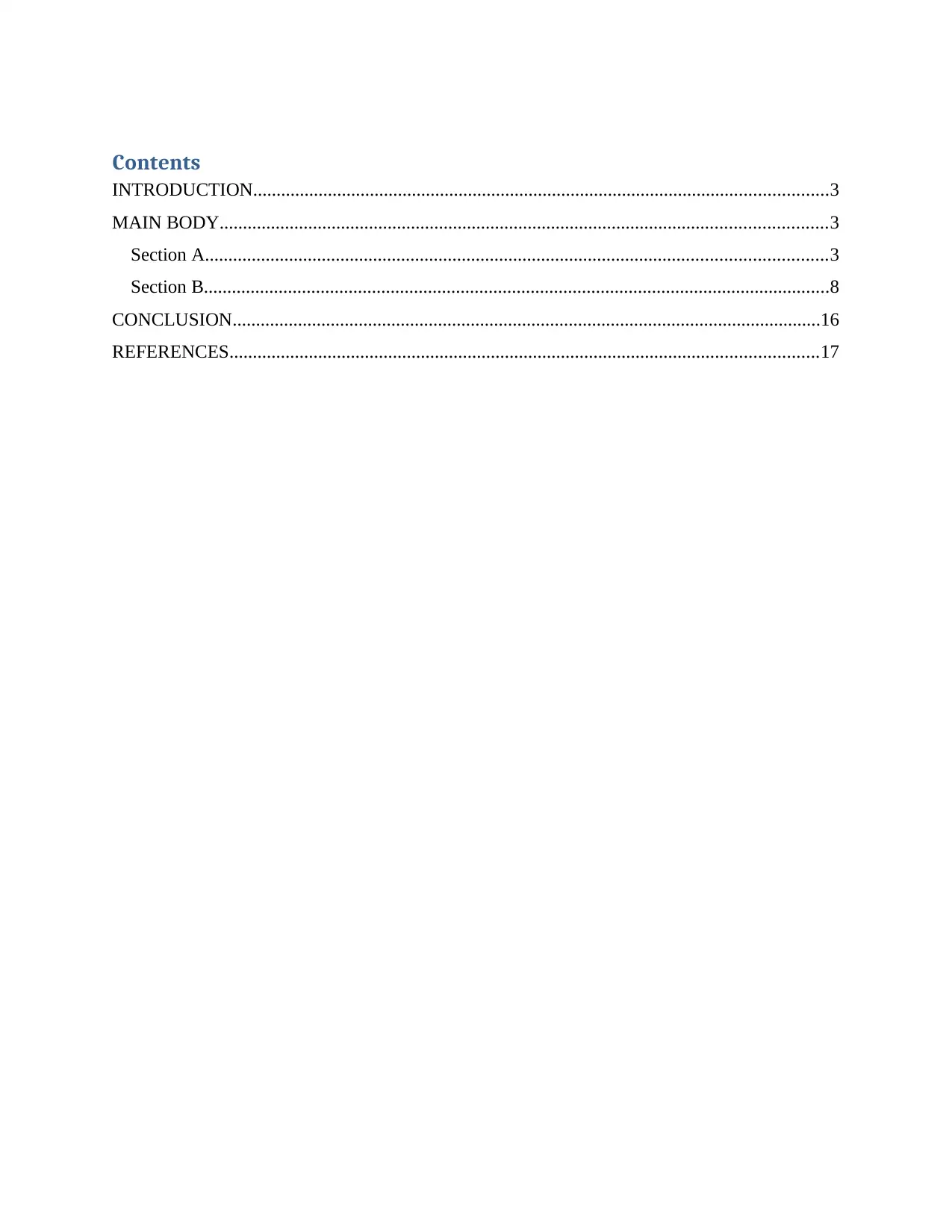
Contents
INTRODUCTION...........................................................................................................................3
MAIN BODY..................................................................................................................................3
Section A.....................................................................................................................................3
Section B......................................................................................................................................8
CONCLUSION..............................................................................................................................16
REFERENCES..............................................................................................................................17
INTRODUCTION...........................................................................................................................3
MAIN BODY..................................................................................................................................3
Section A.....................................................................................................................................3
Section B......................................................................................................................................8
CONCLUSION..............................................................................................................................16
REFERENCES..............................................................................................................................17

INTRODUCTION
Each company or business requires to spend funds in attempt to collect more cash and to
generate daily yields. As a result, the manger has to spend the assets of the company in secure
and sustainable investments. Financial management corresponds to the organizational
scheduling/planning, integration, handling and regulation of financial projects within an entity or
company. Which also involves the application of management concepts to the fiscal assets
of company, while playing essential role in fiscal governance (Shapiro, A.C. and Hanouna, P.,
2019). The Study covers multiple aspects of financial management like approaches and methods
of decision making, investment appraisal technique, ratio analysis and several other in context of
Tesco Plc which is UK’s leading supermarket and grocery chain.
MAIN BODY
Section A
Evaluation of techniques, approaches and factors for better decision making.
Approaches:
Knowledge based approach- Knowledge-based approach entails acknowledging
relevant information as a framework for accomplishing competitive position in market;
here term knowledge entails a tactic for organising and enhancing organisational results. It is
essential for a corporate firm to have knowledge-based approach so that key decisions taken
towards improved performance have some reasonable basis. this provides a major influence
on decision-making process of management within corporation (Al Breiki and Nobanee, 2019).
Formal and Informal approach- It establishes a straightforward roadmap towards
decision-making framework for the corporation. This approach replaces the analytical
approaches to decision-makings and offers an overview of the considerations regarding decision-
making. This aims to enhance the feasibility of picking alternatives which match the diverse
needs of the interested parties of the entity. The uncertainty of the roles is lowered by the
emergence of sensible options. The approach empowers for a relatively convenient revaluation
of the factors, parameters or amendments to the objectives of the interested parties/stakeholders.
This enables corporations to make better informed choices/decision in all dimensions.
Each company or business requires to spend funds in attempt to collect more cash and to
generate daily yields. As a result, the manger has to spend the assets of the company in secure
and sustainable investments. Financial management corresponds to the organizational
scheduling/planning, integration, handling and regulation of financial projects within an entity or
company. Which also involves the application of management concepts to the fiscal assets
of company, while playing essential role in fiscal governance (Shapiro, A.C. and Hanouna, P.,
2019). The Study covers multiple aspects of financial management like approaches and methods
of decision making, investment appraisal technique, ratio analysis and several other in context of
Tesco Plc which is UK’s leading supermarket and grocery chain.
MAIN BODY
Section A
Evaluation of techniques, approaches and factors for better decision making.
Approaches:
Knowledge based approach- Knowledge-based approach entails acknowledging
relevant information as a framework for accomplishing competitive position in market;
here term knowledge entails a tactic for organising and enhancing organisational results. It is
essential for a corporate firm to have knowledge-based approach so that key decisions taken
towards improved performance have some reasonable basis. this provides a major influence
on decision-making process of management within corporation (Al Breiki and Nobanee, 2019).
Formal and Informal approach- It establishes a straightforward roadmap towards
decision-making framework for the corporation. This approach replaces the analytical
approaches to decision-makings and offers an overview of the considerations regarding decision-
making. This aims to enhance the feasibility of picking alternatives which match the diverse
needs of the interested parties of the entity. The uncertainty of the roles is lowered by the
emergence of sensible options. The approach empowers for a relatively convenient revaluation
of the factors, parameters or amendments to the objectives of the interested parties/stakeholders.
This enables corporations to make better informed choices/decision in all dimensions.
⊘ This is a preview!⊘
Do you want full access?
Subscribe today to unlock all pages.

Trusted by 1+ million students worldwide
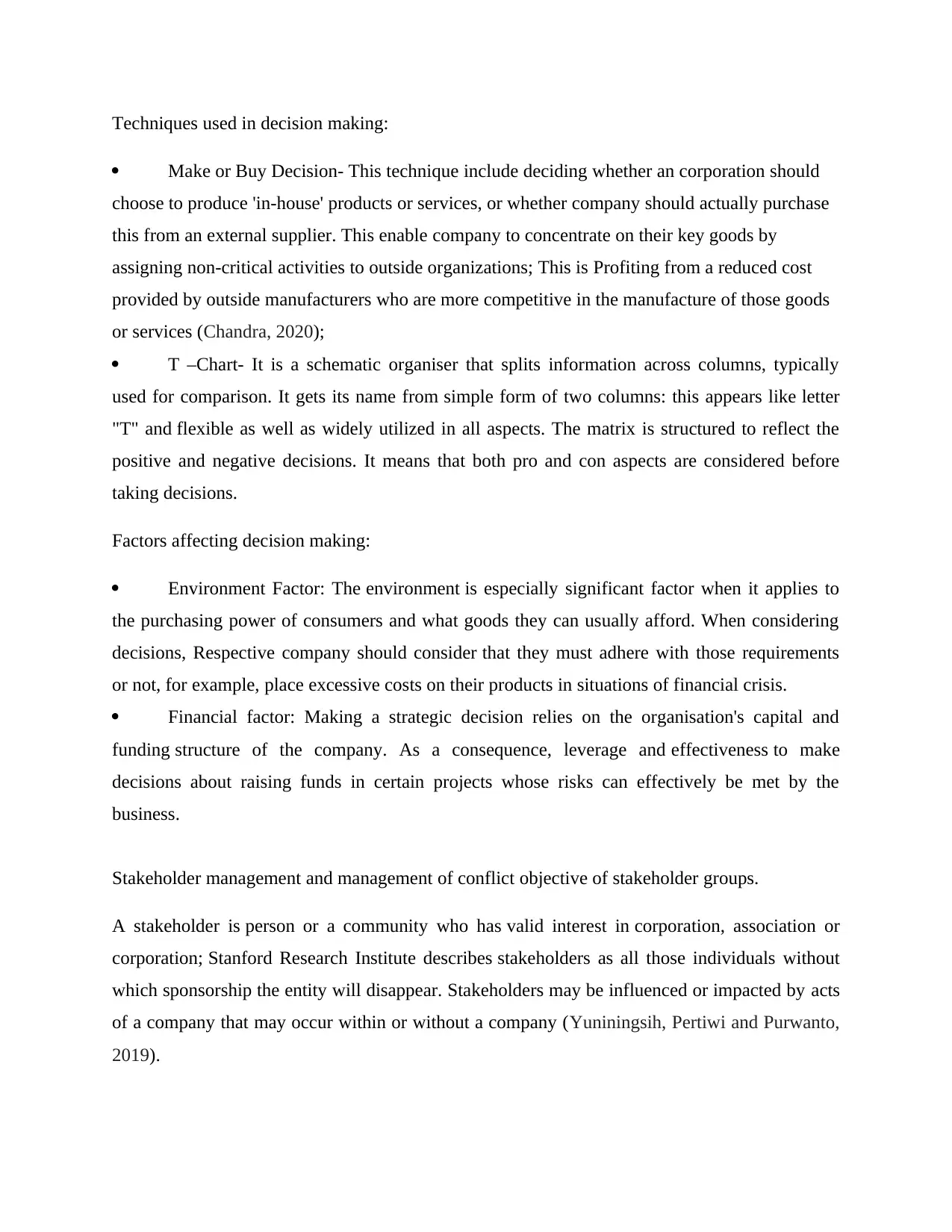
Techniques used in decision making:
Make or Buy Decision- This technique include deciding whether an corporation should
choose to produce 'in-house' products or services, or whether company should actually purchase
this from an external supplier. This enable company to concentrate on their key goods by
assigning non-critical activities to outside organizations; This is Profiting from a reduced cost
provided by outside manufacturers who are more competitive in the manufacture of those goods
or services (Chandra, 2020);
T –Chart- It is a schematic organiser that splits information across columns, typically
used for comparison. It gets its name from simple form of two columns: this appears like letter
"T" and flexible as well as widely utilized in all aspects. The matrix is structured to reflect the
positive and negative decisions. It means that both pro and con aspects are considered before
taking decisions.
Factors affecting decision making:
Environment Factor: The environment is especially significant factor when it applies to
the purchasing power of consumers and what goods they can usually afford. When considering
decisions, Respective company should consider that they must adhere with those requirements
or not, for example, place excessive costs on their products in situations of financial crisis.
Financial factor: Making a strategic decision relies on the organisation's capital and
funding structure of the company. As a consequence, leverage and effectiveness to make
decisions about raising funds in certain projects whose risks can effectively be met by the
business.
Stakeholder management and management of conflict objective of stakeholder groups.
A stakeholder is person or a community who has valid interest in corporation, association or
corporation; Stanford Research Institute describes stakeholders as all those individuals without
which sponsorship the entity will disappear. Stakeholders may be influenced or impacted by acts
of a company that may occur within or without a company (Yuniningsih, Pertiwi and Purwanto,
2019).
Make or Buy Decision- This technique include deciding whether an corporation should
choose to produce 'in-house' products or services, or whether company should actually purchase
this from an external supplier. This enable company to concentrate on their key goods by
assigning non-critical activities to outside organizations; This is Profiting from a reduced cost
provided by outside manufacturers who are more competitive in the manufacture of those goods
or services (Chandra, 2020);
T –Chart- It is a schematic organiser that splits information across columns, typically
used for comparison. It gets its name from simple form of two columns: this appears like letter
"T" and flexible as well as widely utilized in all aspects. The matrix is structured to reflect the
positive and negative decisions. It means that both pro and con aspects are considered before
taking decisions.
Factors affecting decision making:
Environment Factor: The environment is especially significant factor when it applies to
the purchasing power of consumers and what goods they can usually afford. When considering
decisions, Respective company should consider that they must adhere with those requirements
or not, for example, place excessive costs on their products in situations of financial crisis.
Financial factor: Making a strategic decision relies on the organisation's capital and
funding structure of the company. As a consequence, leverage and effectiveness to make
decisions about raising funds in certain projects whose risks can effectively be met by the
business.
Stakeholder management and management of conflict objective of stakeholder groups.
A stakeholder is person or a community who has valid interest in corporation, association or
corporation; Stanford Research Institute describes stakeholders as all those individuals without
which sponsorship the entity will disappear. Stakeholders may be influenced or impacted by acts
of a company that may occur within or without a company (Yuniningsih, Pertiwi and Purwanto,
2019).
Paraphrase This Document
Need a fresh take? Get an instant paraphrase of this document with our AI Paraphraser
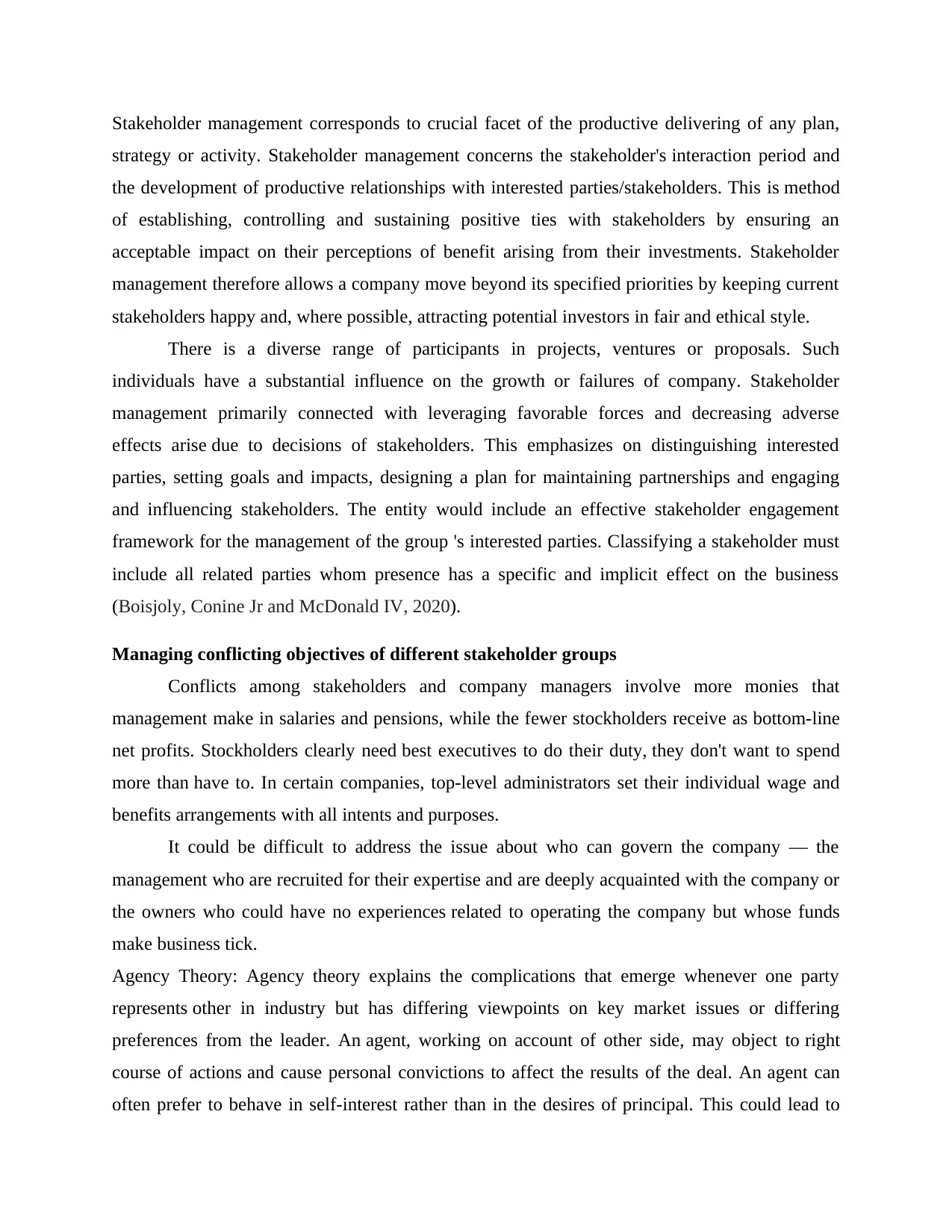
Stakeholder management corresponds to crucial facet of the productive delivering of any plan,
strategy or activity. Stakeholder management concerns the stakeholder's interaction period and
the development of productive relationships with interested parties/stakeholders. This is method
of establishing, controlling and sustaining positive ties with stakeholders by ensuring an
acceptable impact on their perceptions of benefit arising from their investments. Stakeholder
management therefore allows a company move beyond its specified priorities by keeping current
stakeholders happy and, where possible, attracting potential investors in fair and ethical style.
There is a diverse range of participants in projects, ventures or proposals. Such
individuals have a substantial influence on the growth or failures of company. Stakeholder
management primarily connected with leveraging favorable forces and decreasing adverse
effects arise due to decisions of stakeholders. This emphasizes on distinguishing interested
parties, setting goals and impacts, designing a plan for maintaining partnerships and engaging
and influencing stakeholders. The entity would include an effective stakeholder engagement
framework for the management of the group 's interested parties. Classifying a stakeholder must
include all related parties whom presence has a specific and implicit effect on the business
(Boisjoly, Conine Jr and McDonald IV, 2020).
Managing conflicting objectives of different stakeholder groups
Conflicts among stakeholders and company managers involve more monies that
management make in salaries and pensions, while the fewer stockholders receive as bottom-line
net profits. Stockholders clearly need best executives to do their duty, they don't want to spend
more than have to. In certain companies, top-level administrators set their individual wage and
benefits arrangements with all intents and purposes.
It could be difficult to address the issue about who can govern the company — the
management who are recruited for their expertise and are deeply acquainted with the company or
the owners who could have no experiences related to operating the company but whose funds
make business tick.
Agency Theory: Agency theory explains the complications that emerge whenever one party
represents other in industry but has differing viewpoints on key market issues or differing
preferences from the leader. An agent, working on account of other side, may object to right
course of actions and cause personal convictions to affect the results of the deal. An agent can
often prefer to behave in self-interest rather than in the desires of principal. This could lead to
strategy or activity. Stakeholder management concerns the stakeholder's interaction period and
the development of productive relationships with interested parties/stakeholders. This is method
of establishing, controlling and sustaining positive ties with stakeholders by ensuring an
acceptable impact on their perceptions of benefit arising from their investments. Stakeholder
management therefore allows a company move beyond its specified priorities by keeping current
stakeholders happy and, where possible, attracting potential investors in fair and ethical style.
There is a diverse range of participants in projects, ventures or proposals. Such
individuals have a substantial influence on the growth or failures of company. Stakeholder
management primarily connected with leveraging favorable forces and decreasing adverse
effects arise due to decisions of stakeholders. This emphasizes on distinguishing interested
parties, setting goals and impacts, designing a plan for maintaining partnerships and engaging
and influencing stakeholders. The entity would include an effective stakeholder engagement
framework for the management of the group 's interested parties. Classifying a stakeholder must
include all related parties whom presence has a specific and implicit effect on the business
(Boisjoly, Conine Jr and McDonald IV, 2020).
Managing conflicting objectives of different stakeholder groups
Conflicts among stakeholders and company managers involve more monies that
management make in salaries and pensions, while the fewer stockholders receive as bottom-line
net profits. Stockholders clearly need best executives to do their duty, they don't want to spend
more than have to. In certain companies, top-level administrators set their individual wage and
benefits arrangements with all intents and purposes.
It could be difficult to address the issue about who can govern the company — the
management who are recruited for their expertise and are deeply acquainted with the company or
the owners who could have no experiences related to operating the company but whose funds
make business tick.
Agency Theory: Agency theory explains the complications that emerge whenever one party
represents other in industry but has differing viewpoints on key market issues or differing
preferences from the leader. An agent, working on account of other side, may object to right
course of actions and cause personal convictions to affect the results of the deal. An agent can
often prefer to behave in self-interest rather than in the desires of principal. This could lead to
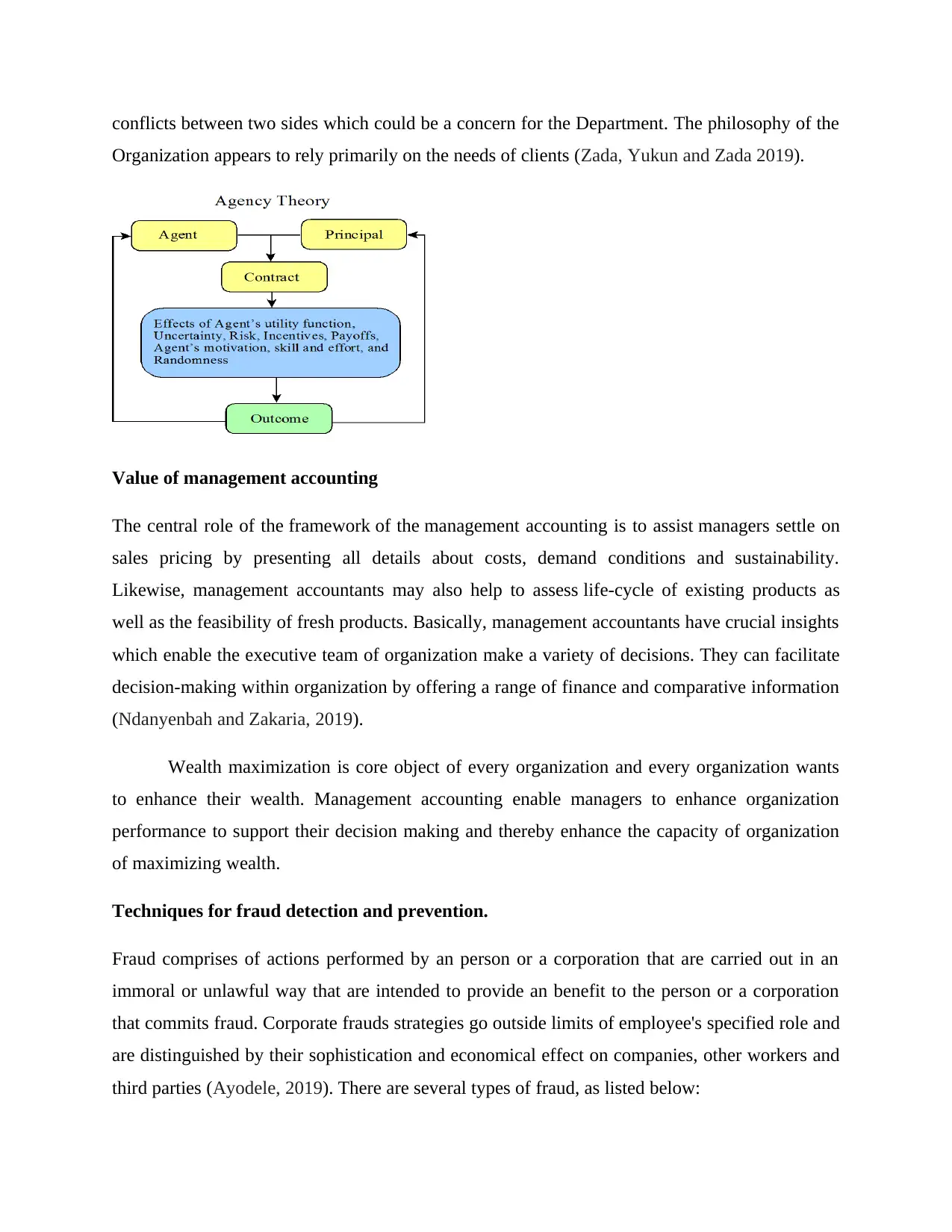
conflicts between two sides which could be a concern for the Department. The philosophy of the
Organization appears to rely primarily on the needs of clients (Zada, Yukun and Zada 2019).
Value of management accounting
The central role of the framework of the management accounting is to assist managers settle on
sales pricing by presenting all details about costs, demand conditions and sustainability.
Likewise, management accountants may also help to assess life-cycle of existing products as
well as the feasibility of fresh products. Basically, management accountants have crucial insights
which enable the executive team of organization make a variety of decisions. They can facilitate
decision-making within organization by offering a range of finance and comparative information
(Ndanyenbah and Zakaria, 2019).
Wealth maximization is core object of every organization and every organization wants
to enhance their wealth. Management accounting enable managers to enhance organization
performance to support their decision making and thereby enhance the capacity of organization
of maximizing wealth.
Techniques for fraud detection and prevention.
Fraud comprises of actions performed by an person or a corporation that are carried out in an
immoral or unlawful way that are intended to provide an benefit to the person or a corporation
that commits fraud. Corporate frauds strategies go outside limits of employee's specified role and
are distinguished by their sophistication and economical effect on companies, other workers and
third parties (Ayodele, 2019). There are several types of fraud, as listed below:
Organization appears to rely primarily on the needs of clients (Zada, Yukun and Zada 2019).
Value of management accounting
The central role of the framework of the management accounting is to assist managers settle on
sales pricing by presenting all details about costs, demand conditions and sustainability.
Likewise, management accountants may also help to assess life-cycle of existing products as
well as the feasibility of fresh products. Basically, management accountants have crucial insights
which enable the executive team of organization make a variety of decisions. They can facilitate
decision-making within organization by offering a range of finance and comparative information
(Ndanyenbah and Zakaria, 2019).
Wealth maximization is core object of every organization and every organization wants
to enhance their wealth. Management accounting enable managers to enhance organization
performance to support their decision making and thereby enhance the capacity of organization
of maximizing wealth.
Techniques for fraud detection and prevention.
Fraud comprises of actions performed by an person or a corporation that are carried out in an
immoral or unlawful way that are intended to provide an benefit to the person or a corporation
that commits fraud. Corporate frauds strategies go outside limits of employee's specified role and
are distinguished by their sophistication and economical effect on companies, other workers and
third parties (Ayodele, 2019). There are several types of fraud, as listed below:
⊘ This is a preview!⊘
Do you want full access?
Subscribe today to unlock all pages.

Trusted by 1+ million students worldwide
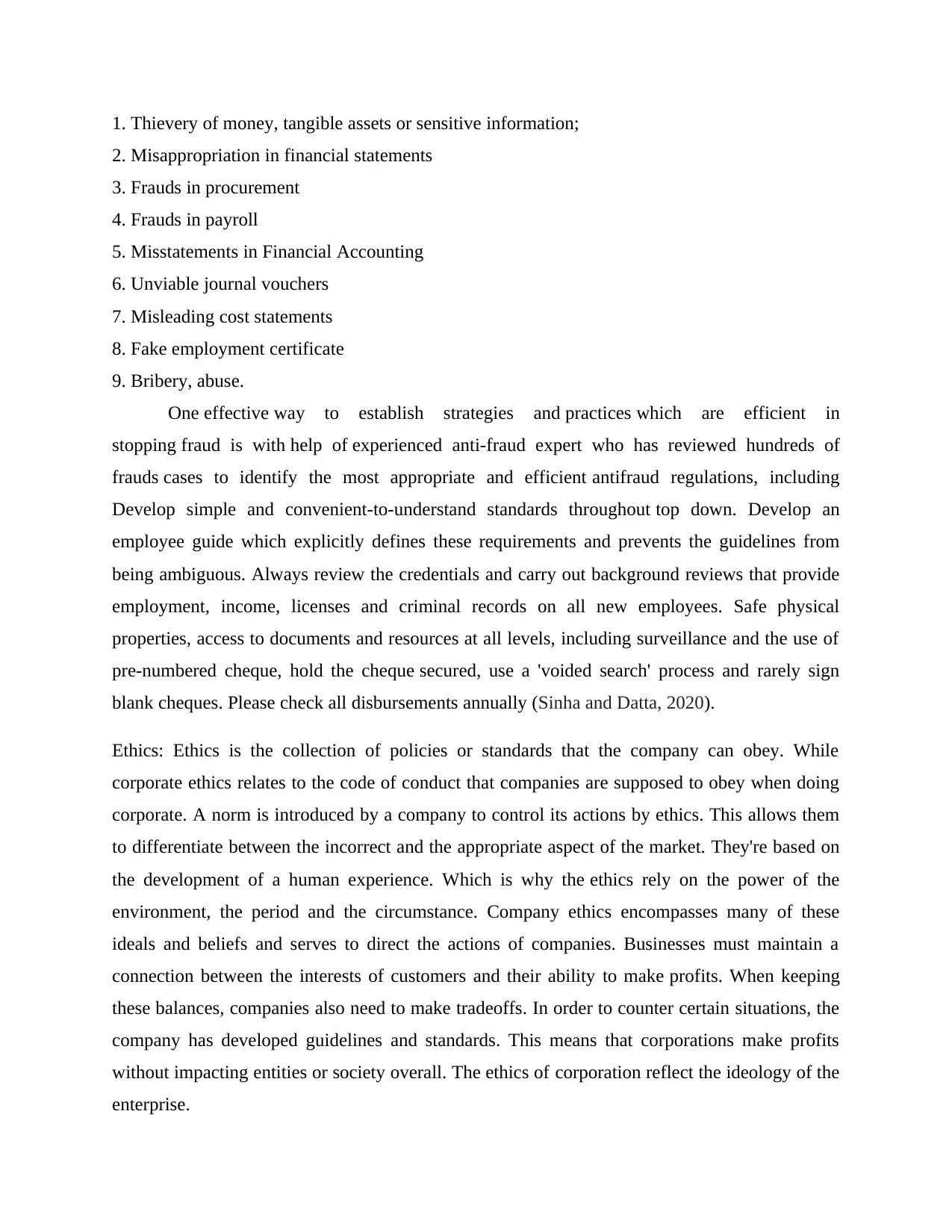
1. Thievery of money, tangible assets or sensitive information;
2. Misappropriation in financial statements
3. Frauds in procurement
4. Frauds in payroll
5. Misstatements in Financial Accounting
6. Unviable journal vouchers
7. Misleading cost statements
8. Fake employment certificate
9. Bribery, abuse.
One effective way to establish strategies and practices which are efficient in
stopping fraud is with help of experienced anti-fraud expert who has reviewed hundreds of
frauds cases to identify the most appropriate and efficient antifraud regulations, including
Develop simple and convenient-to-understand standards throughout top down. Develop an
employee guide which explicitly defines these requirements and prevents the guidelines from
being ambiguous. Always review the credentials and carry out background reviews that provide
employment, income, licenses and criminal records on all new employees. Safe physical
properties, access to documents and resources at all levels, including surveillance and the use of
pre-numbered cheque, hold the cheque secured, use a 'voided search' process and rarely sign
blank cheques. Please check all disbursements annually (Sinha and Datta, 2020).
Ethics: Ethics is the collection of policies or standards that the company can obey. While
corporate ethics relates to the code of conduct that companies are supposed to obey when doing
corporate. A norm is introduced by a company to control its actions by ethics. This allows them
to differentiate between the incorrect and the appropriate aspect of the market. They're based on
the development of a human experience. Which is why the ethics rely on the power of the
environment, the period and the circumstance. Company ethics encompasses many of these
ideals and beliefs and serves to direct the actions of companies. Businesses must maintain a
connection between the interests of customers and their ability to make profits. When keeping
these balances, companies also need to make tradeoffs. In order to counter certain situations, the
company has developed guidelines and standards. This means that corporations make profits
without impacting entities or society overall. The ethics of corporation reflect the ideology of the
enterprise.
2. Misappropriation in financial statements
3. Frauds in procurement
4. Frauds in payroll
5. Misstatements in Financial Accounting
6. Unviable journal vouchers
7. Misleading cost statements
8. Fake employment certificate
9. Bribery, abuse.
One effective way to establish strategies and practices which are efficient in
stopping fraud is with help of experienced anti-fraud expert who has reviewed hundreds of
frauds cases to identify the most appropriate and efficient antifraud regulations, including
Develop simple and convenient-to-understand standards throughout top down. Develop an
employee guide which explicitly defines these requirements and prevents the guidelines from
being ambiguous. Always review the credentials and carry out background reviews that provide
employment, income, licenses and criminal records on all new employees. Safe physical
properties, access to documents and resources at all levels, including surveillance and the use of
pre-numbered cheque, hold the cheque secured, use a 'voided search' process and rarely sign
blank cheques. Please check all disbursements annually (Sinha and Datta, 2020).
Ethics: Ethics is the collection of policies or standards that the company can obey. While
corporate ethics relates to the code of conduct that companies are supposed to obey when doing
corporate. A norm is introduced by a company to control its actions by ethics. This allows them
to differentiate between the incorrect and the appropriate aspect of the market. They're based on
the development of a human experience. Which is why the ethics rely on the power of the
environment, the period and the circumstance. Company ethics encompasses many of these
ideals and beliefs and serves to direct the actions of companies. Businesses must maintain a
connection between the interests of customers and their ability to make profits. When keeping
these balances, companies also need to make tradeoffs. In order to counter certain situations, the
company has developed guidelines and standards. This means that corporations make profits
without impacting entities or society overall. The ethics of corporation reflect the ideology of the
enterprise.
Paraphrase This Document
Need a fresh take? Get an instant paraphrase of this document with our AI Paraphraser
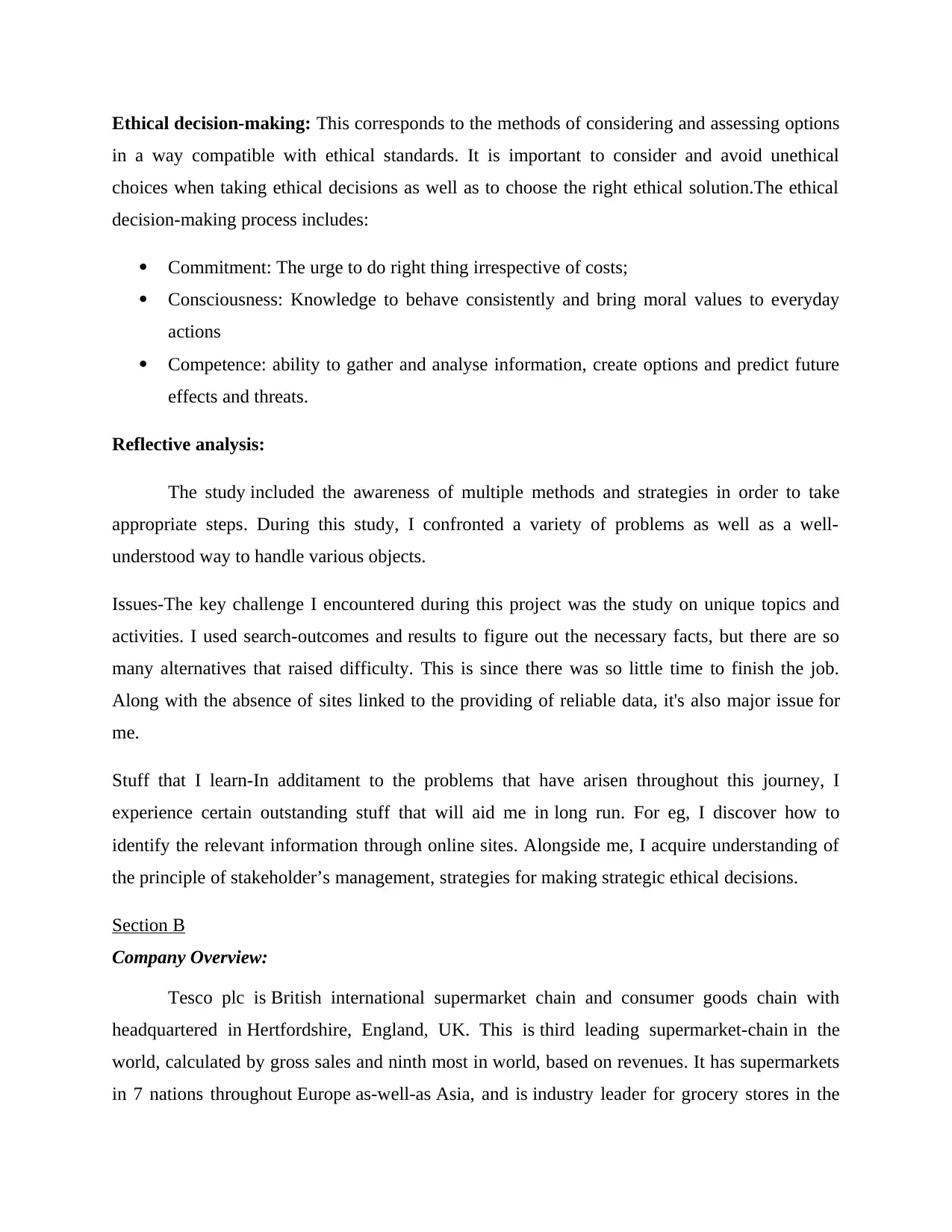
Ethical decision-making: This corresponds to the methods of considering and assessing options
in a way compatible with ethical standards. It is important to consider and avoid unethical
choices when taking ethical decisions as well as to choose the right ethical solution.The ethical
decision-making process includes:
Commitment: The urge to do right thing irrespective of costs;
Consciousness: Knowledge to behave consistently and bring moral values to everyday
actions
Competence: ability to gather and analyse information, create options and predict future
effects and threats.
Reflective analysis:
The study included the awareness of multiple methods and strategies in order to take
appropriate steps. During this study, I confronted a variety of problems as well as a well-
understood way to handle various objects.
Issues-The key challenge I encountered during this project was the study on unique topics and
activities. I used search-outcomes and results to figure out the necessary facts, but there are so
many alternatives that raised difficulty. This is since there was so little time to finish the job.
Along with the absence of sites linked to the providing of reliable data, it's also major issue for
me.
Stuff that I learn-In additament to the problems that have arisen throughout this journey, I
experience certain outstanding stuff that will aid me in long run. For eg, I discover how to
identify the relevant information through online sites. Alongside me, I acquire understanding of
the principle of stakeholder’s management, strategies for making strategic ethical decisions.
Section B
Company Overview:
Tesco plc is British international supermarket chain and consumer goods chain with
headquartered in Hertfordshire, England, UK. This is third leading supermarket-chain in the
world, calculated by gross sales and ninth most in world, based on revenues. It has supermarkets
in 7 nations throughout Europe as-well-as Asia, and is industry leader for grocery stores in the
in a way compatible with ethical standards. It is important to consider and avoid unethical
choices when taking ethical decisions as well as to choose the right ethical solution.The ethical
decision-making process includes:
Commitment: The urge to do right thing irrespective of costs;
Consciousness: Knowledge to behave consistently and bring moral values to everyday
actions
Competence: ability to gather and analyse information, create options and predict future
effects and threats.
Reflective analysis:
The study included the awareness of multiple methods and strategies in order to take
appropriate steps. During this study, I confronted a variety of problems as well as a well-
understood way to handle various objects.
Issues-The key challenge I encountered during this project was the study on unique topics and
activities. I used search-outcomes and results to figure out the necessary facts, but there are so
many alternatives that raised difficulty. This is since there was so little time to finish the job.
Along with the absence of sites linked to the providing of reliable data, it's also major issue for
me.
Stuff that I learn-In additament to the problems that have arisen throughout this journey, I
experience certain outstanding stuff that will aid me in long run. For eg, I discover how to
identify the relevant information through online sites. Alongside me, I acquire understanding of
the principle of stakeholder’s management, strategies for making strategic ethical decisions.
Section B
Company Overview:
Tesco plc is British international supermarket chain and consumer goods chain with
headquartered in Hertfordshire, England, UK. This is third leading supermarket-chain in the
world, calculated by gross sales and ninth most in world, based on revenues. It has supermarkets
in 7 nations throughout Europe as-well-as Asia, and is industry leader for grocery stores in the
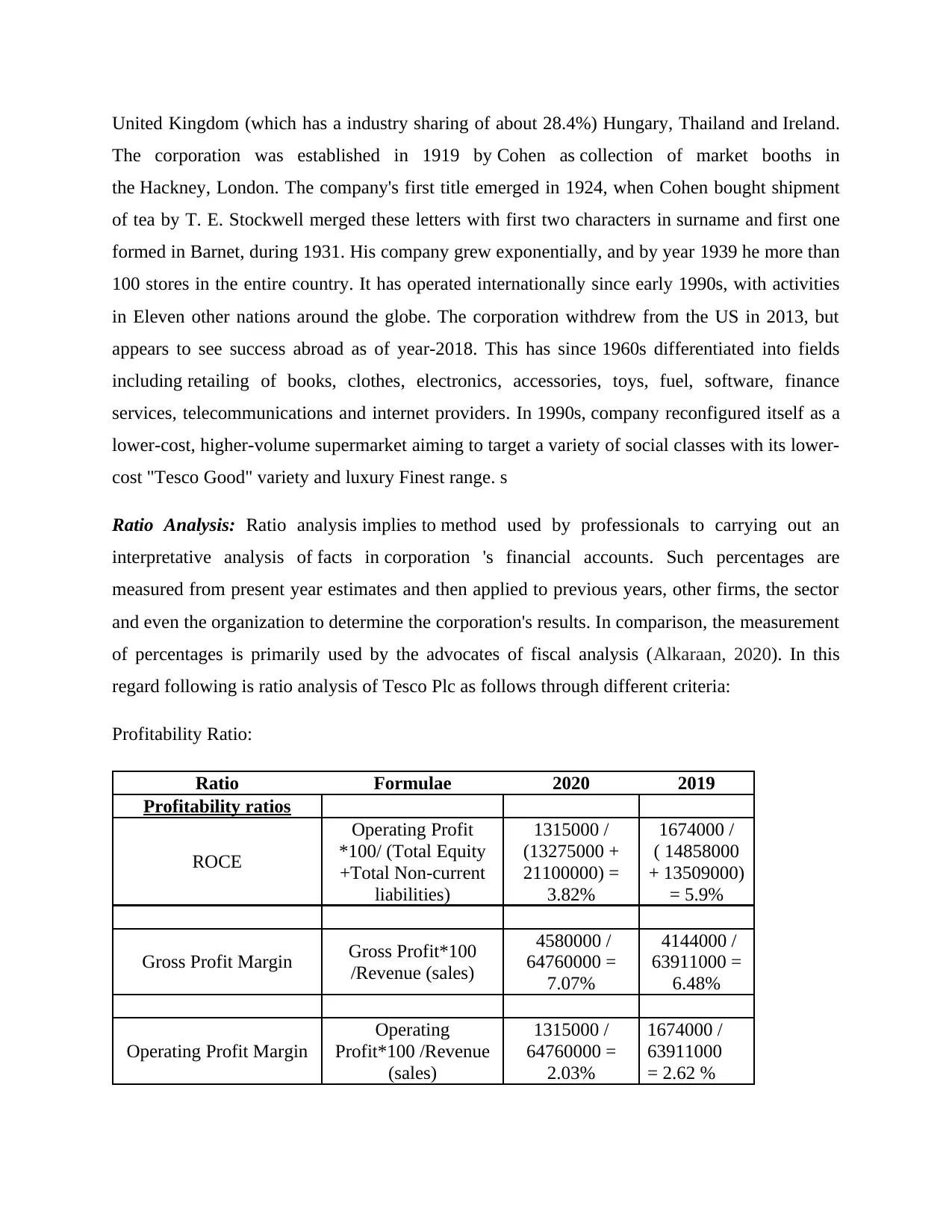
United Kingdom (which has a industry sharing of about 28.4%) Hungary, Thailand and Ireland.
The corporation was established in 1919 by Cohen as collection of market booths in
the Hackney, London. The company's first title emerged in 1924, when Cohen bought shipment
of tea by T. E. Stockwell merged these letters with first two characters in surname and first one
formed in Barnet, during 1931. His company grew exponentially, and by year 1939 he more than
100 stores in the entire country. It has operated internationally since early 1990s, with activities
in Eleven other nations around the globe. The corporation withdrew from the US in 2013, but
appears to see success abroad as of year-2018. This has since 1960s differentiated into fields
including retailing of books, clothes, electronics, accessories, toys, fuel, software, finance
services, telecommunications and internet providers. In 1990s, company reconfigured itself as a
lower-cost, higher-volume supermarket aiming to target a variety of social classes with its lower-
cost "Tesco Good" variety and luxury Finest range. s
Ratio Analysis: Ratio analysis implies to method used by professionals to carrying out an
interpretative analysis of facts in corporation 's financial accounts. Such percentages are
measured from present year estimates and then applied to previous years, other firms, the sector
and even the organization to determine the corporation's results. In comparison, the measurement
of percentages is primarily used by the advocates of fiscal analysis (Alkaraan, 2020). In this
regard following is ratio analysis of Tesco Plc as follows through different criteria:
Profitability Ratio:
Ratio Formulae 2020 2019
Profitability ratios
ROCE
Operating Profit
*100/ (Total Equity
+Total Non-current
liabilities)
1315000 /
(13275000 +
21100000) =
3.82%
1674000 /
( 14858000
+ 13509000)
= 5.9%
Gross Profit Margin Gross Profit*100
/Revenue (sales)
4580000 /
64760000 =
7.07%
4144000 /
63911000 =
6.48%
Operating Profit Margin
Operating
Profit*100 /Revenue
(sales)
1315000 /
64760000 =
2.03%
1674000 /
63911000
= 2.62 %
The corporation was established in 1919 by Cohen as collection of market booths in
the Hackney, London. The company's first title emerged in 1924, when Cohen bought shipment
of tea by T. E. Stockwell merged these letters with first two characters in surname and first one
formed in Barnet, during 1931. His company grew exponentially, and by year 1939 he more than
100 stores in the entire country. It has operated internationally since early 1990s, with activities
in Eleven other nations around the globe. The corporation withdrew from the US in 2013, but
appears to see success abroad as of year-2018. This has since 1960s differentiated into fields
including retailing of books, clothes, electronics, accessories, toys, fuel, software, finance
services, telecommunications and internet providers. In 1990s, company reconfigured itself as a
lower-cost, higher-volume supermarket aiming to target a variety of social classes with its lower-
cost "Tesco Good" variety and luxury Finest range. s
Ratio Analysis: Ratio analysis implies to method used by professionals to carrying out an
interpretative analysis of facts in corporation 's financial accounts. Such percentages are
measured from present year estimates and then applied to previous years, other firms, the sector
and even the organization to determine the corporation's results. In comparison, the measurement
of percentages is primarily used by the advocates of fiscal analysis (Alkaraan, 2020). In this
regard following is ratio analysis of Tesco Plc as follows through different criteria:
Profitability Ratio:
Ratio Formulae 2020 2019
Profitability ratios
ROCE
Operating Profit
*100/ (Total Equity
+Total Non-current
liabilities)
1315000 /
(13275000 +
21100000) =
3.82%
1674000 /
( 14858000
+ 13509000)
= 5.9%
Gross Profit Margin Gross Profit*100
/Revenue (sales)
4580000 /
64760000 =
7.07%
4144000 /
63911000 =
6.48%
Operating Profit Margin
Operating
Profit*100 /Revenue
(sales)
1315000 /
64760000 =
2.03%
1674000 /
63911000
= 2.62 %
⊘ This is a preview!⊘
Do you want full access?
Subscribe today to unlock all pages.

Trusted by 1+ million students worldwide
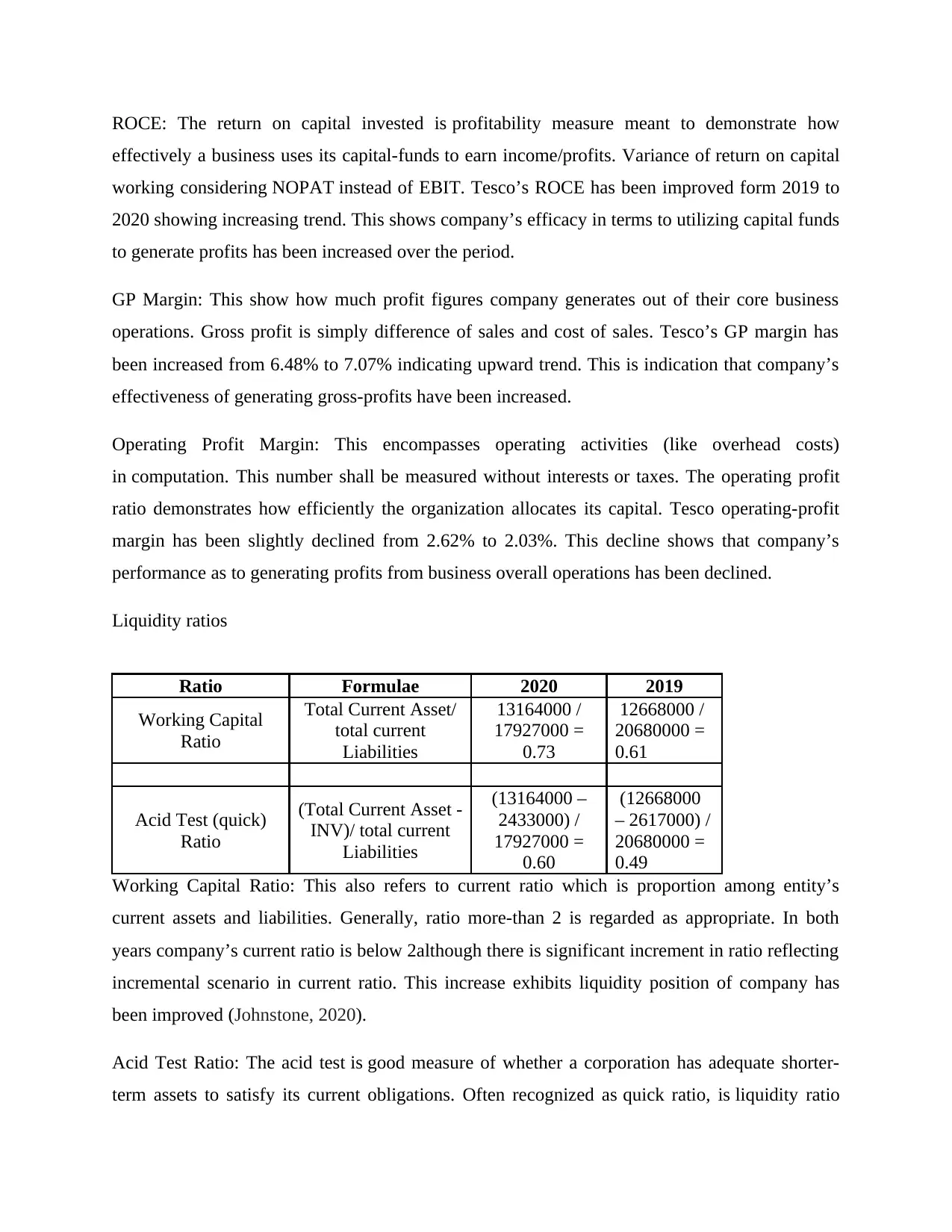
ROCE: The return on capital invested is profitability measure meant to demonstrate how
effectively a business uses its capital-funds to earn income/profits. Variance of return on capital
working considering NOPAT instead of EBIT. Tesco’s ROCE has been improved form 2019 to
2020 showing increasing trend. This shows company’s efficacy in terms to utilizing capital funds
to generate profits has been increased over the period.
GP Margin: This show how much profit figures company generates out of their core business
operations. Gross profit is simply difference of sales and cost of sales. Tesco’s GP margin has
been increased from 6.48% to 7.07% indicating upward trend. This is indication that company’s
effectiveness of generating gross-profits have been increased.
Operating Profit Margin: This encompasses operating activities (like overhead costs)
in computation. This number shall be measured without interests or taxes. The operating profit
ratio demonstrates how efficiently the organization allocates its capital. Tesco operating-profit
margin has been slightly declined from 2.62% to 2.03%. This decline shows that company’s
performance as to generating profits from business overall operations has been declined.
Liquidity ratios
Ratio Formulae 2020 2019
Working Capital
Ratio
Total Current Asset/
total current
Liabilities
13164000 /
17927000 =
0.73
12668000 /
20680000 =
0.61
Acid Test (quick)
Ratio
(Total Current Asset -
INV)/ total current
Liabilities
(13164000 –
2433000) /
17927000 =
0.60
(12668000
– 2617000) /
20680000 =
0.49
Working Capital Ratio: This also refers to current ratio which is proportion among entity’s
current assets and liabilities. Generally, ratio more-than 2 is regarded as appropriate. In both
years company’s current ratio is below 2although there is significant increment in ratio reflecting
incremental scenario in current ratio. This increase exhibits liquidity position of company has
been improved (Johnstone, 2020).
Acid Test Ratio: The acid test is good measure of whether a corporation has adequate shorter-
term assets to satisfy its current obligations. Often recognized as quick ratio, is liquidity ratio
effectively a business uses its capital-funds to earn income/profits. Variance of return on capital
working considering NOPAT instead of EBIT. Tesco’s ROCE has been improved form 2019 to
2020 showing increasing trend. This shows company’s efficacy in terms to utilizing capital funds
to generate profits has been increased over the period.
GP Margin: This show how much profit figures company generates out of their core business
operations. Gross profit is simply difference of sales and cost of sales. Tesco’s GP margin has
been increased from 6.48% to 7.07% indicating upward trend. This is indication that company’s
effectiveness of generating gross-profits have been increased.
Operating Profit Margin: This encompasses operating activities (like overhead costs)
in computation. This number shall be measured without interests or taxes. The operating profit
ratio demonstrates how efficiently the organization allocates its capital. Tesco operating-profit
margin has been slightly declined from 2.62% to 2.03%. This decline shows that company’s
performance as to generating profits from business overall operations has been declined.
Liquidity ratios
Ratio Formulae 2020 2019
Working Capital
Ratio
Total Current Asset/
total current
Liabilities
13164000 /
17927000 =
0.73
12668000 /
20680000 =
0.61
Acid Test (quick)
Ratio
(Total Current Asset -
INV)/ total current
Liabilities
(13164000 –
2433000) /
17927000 =
0.60
(12668000
– 2617000) /
20680000 =
0.49
Working Capital Ratio: This also refers to current ratio which is proportion among entity’s
current assets and liabilities. Generally, ratio more-than 2 is regarded as appropriate. In both
years company’s current ratio is below 2although there is significant increment in ratio reflecting
incremental scenario in current ratio. This increase exhibits liquidity position of company has
been improved (Johnstone, 2020).
Acid Test Ratio: The acid test is good measure of whether a corporation has adequate shorter-
term assets to satisfy its current obligations. Often recognized as quick ratio, is liquidity ratio
Paraphrase This Document
Need a fresh take? Get an instant paraphrase of this document with our AI Paraphraser
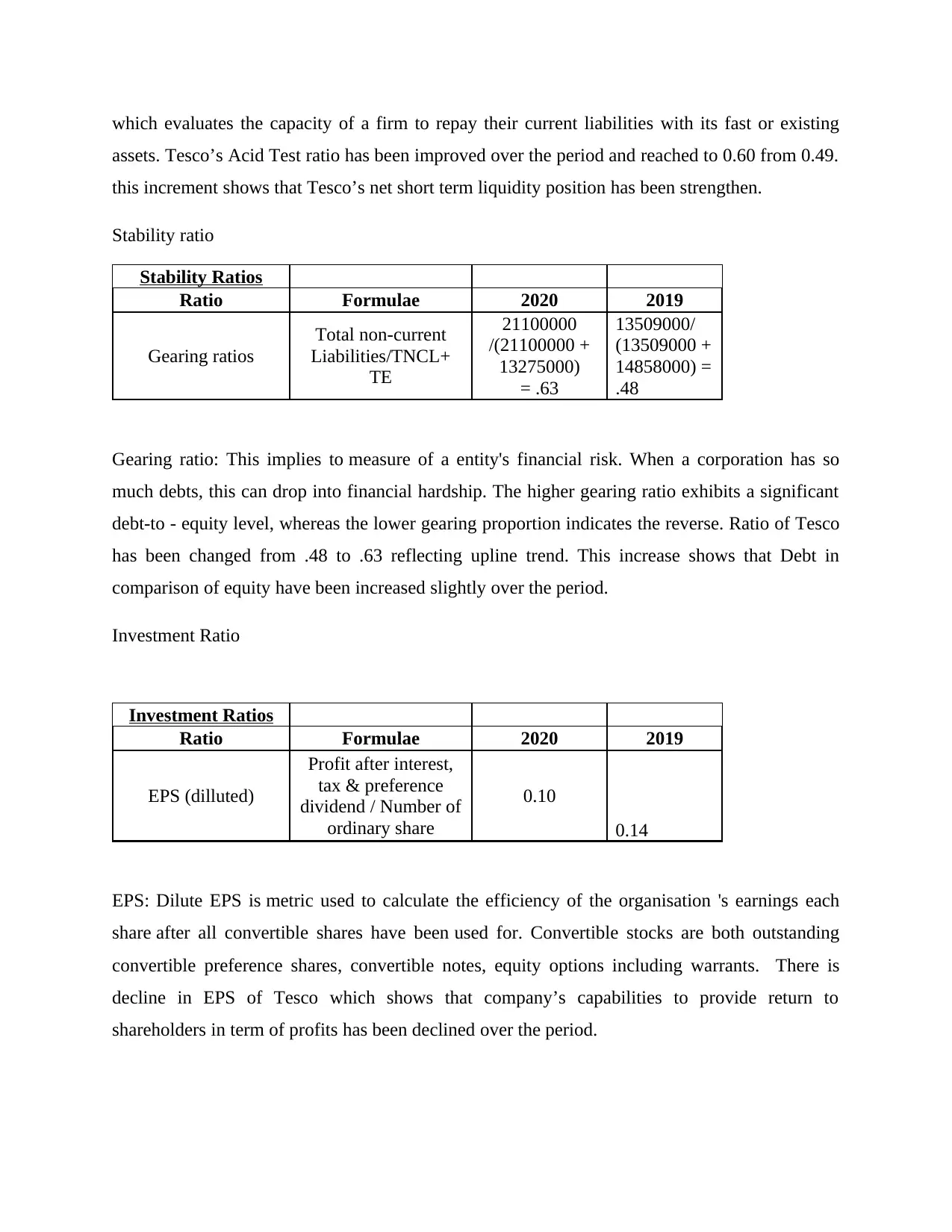
which evaluates the capacity of a firm to repay their current liabilities with its fast or existing
assets. Tesco’s Acid Test ratio has been improved over the period and reached to 0.60 from 0.49.
this increment shows that Tesco’s net short term liquidity position has been strengthen.
Stability ratio
Stability Ratios
Ratio Formulae 2020 2019
Gearing ratios
Total non-current
Liabilities/TNCL+
TE
21100000
/(21100000 +
13275000)
= .63
13509000/
(13509000 +
14858000) =
.48
Gearing ratio: This implies to measure of a entity's financial risk. When a corporation has so
much debts, this can drop into financial hardship. The higher gearing ratio exhibits a significant
debt-to - equity level, whereas the lower gearing proportion indicates the reverse. Ratio of Tesco
has been changed from .48 to .63 reflecting upline trend. This increase shows that Debt in
comparison of equity have been increased slightly over the period.
Investment Ratio
Investment Ratios
Ratio Formulae 2020 2019
EPS (dilluted)
Profit after interest,
tax & preference
dividend / Number of
ordinary share
0.10
0.14
EPS: Dilute EPS is metric used to calculate the efficiency of the organisation 's earnings each
share after all convertible shares have been used for. Convertible stocks are both outstanding
convertible preference shares, convertible notes, equity options including warrants. There is
decline in EPS of Tesco which shows that company’s capabilities to provide return to
shareholders in term of profits has been declined over the period.
assets. Tesco’s Acid Test ratio has been improved over the period and reached to 0.60 from 0.49.
this increment shows that Tesco’s net short term liquidity position has been strengthen.
Stability ratio
Stability Ratios
Ratio Formulae 2020 2019
Gearing ratios
Total non-current
Liabilities/TNCL+
TE
21100000
/(21100000 +
13275000)
= .63
13509000/
(13509000 +
14858000) =
.48
Gearing ratio: This implies to measure of a entity's financial risk. When a corporation has so
much debts, this can drop into financial hardship. The higher gearing ratio exhibits a significant
debt-to - equity level, whereas the lower gearing proportion indicates the reverse. Ratio of Tesco
has been changed from .48 to .63 reflecting upline trend. This increase shows that Debt in
comparison of equity have been increased slightly over the period.
Investment Ratio
Investment Ratios
Ratio Formulae 2020 2019
EPS (dilluted)
Profit after interest,
tax & preference
dividend / Number of
ordinary share
0.10
0.14
EPS: Dilute EPS is metric used to calculate the efficiency of the organisation 's earnings each
share after all convertible shares have been used for. Convertible stocks are both outstanding
convertible preference shares, convertible notes, equity options including warrants. There is
decline in EPS of Tesco which shows that company’s capabilities to provide return to
shareholders in term of profits has been declined over the period.
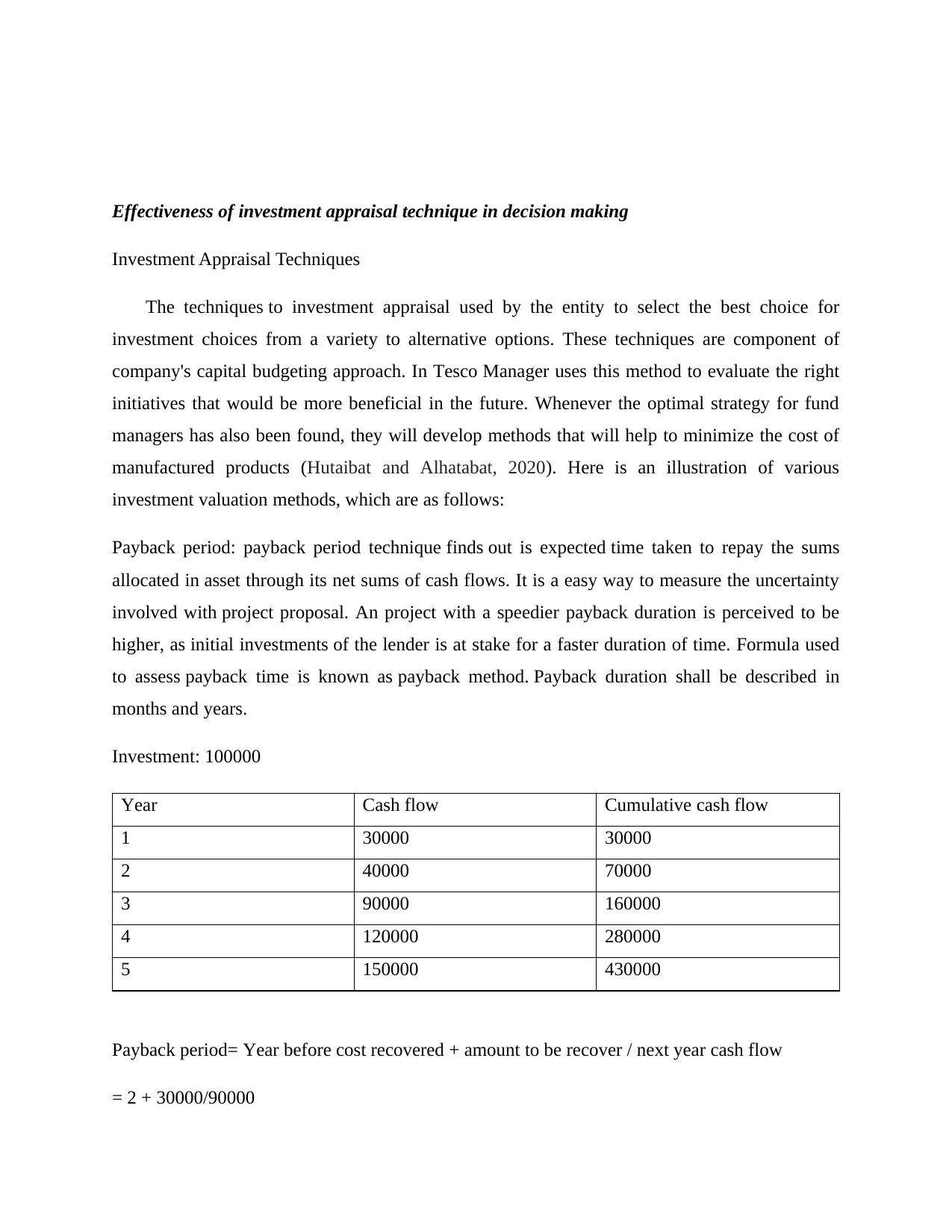
Effectiveness of investment appraisal technique in decision making
Investment Appraisal Techniques
The techniques to investment appraisal used by the entity to select the best choice for
investment choices from a variety to alternative options. These techniques are component of
company's capital budgeting approach. In Tesco Manager uses this method to evaluate the right
initiatives that would be more beneficial in the future. Whenever the optimal strategy for fund
managers has also been found, they will develop methods that will help to minimize the cost of
manufactured products (Hutaibat and Alhatabat, 2020). Here is an illustration of various
investment valuation methods, which are as follows:
Payback period: payback period technique finds out is expected time taken to repay the sums
allocated in asset through its net sums of cash flows. It is a easy way to measure the uncertainty
involved with project proposal. An project with a speedier payback duration is perceived to be
higher, as initial investments of the lender is at stake for a faster duration of time. Formula used
to assess payback time is known as payback method. Payback duration shall be described in
months and years.
Investment: 100000
Year Cash flow Cumulative cash flow
1 30000 30000
2 40000 70000
3 90000 160000
4 120000 280000
5 150000 430000
Payback period= Year before cost recovered + amount to be recover / next year cash flow
= 2 + 30000/90000
Investment Appraisal Techniques
The techniques to investment appraisal used by the entity to select the best choice for
investment choices from a variety to alternative options. These techniques are component of
company's capital budgeting approach. In Tesco Manager uses this method to evaluate the right
initiatives that would be more beneficial in the future. Whenever the optimal strategy for fund
managers has also been found, they will develop methods that will help to minimize the cost of
manufactured products (Hutaibat and Alhatabat, 2020). Here is an illustration of various
investment valuation methods, which are as follows:
Payback period: payback period technique finds out is expected time taken to repay the sums
allocated in asset through its net sums of cash flows. It is a easy way to measure the uncertainty
involved with project proposal. An project with a speedier payback duration is perceived to be
higher, as initial investments of the lender is at stake for a faster duration of time. Formula used
to assess payback time is known as payback method. Payback duration shall be described in
months and years.
Investment: 100000
Year Cash flow Cumulative cash flow
1 30000 30000
2 40000 70000
3 90000 160000
4 120000 280000
5 150000 430000
Payback period= Year before cost recovered + amount to be recover / next year cash flow
= 2 + 30000/90000
⊘ This is a preview!⊘
Do you want full access?
Subscribe today to unlock all pages.

Trusted by 1+ million students worldwide
1 out of 17
Related Documents
Your All-in-One AI-Powered Toolkit for Academic Success.
+13062052269
info@desklib.com
Available 24*7 on WhatsApp / Email
![[object Object]](/_next/static/media/star-bottom.7253800d.svg)
Unlock your academic potential
Copyright © 2020–2025 A2Z Services. All Rights Reserved. Developed and managed by ZUCOL.




